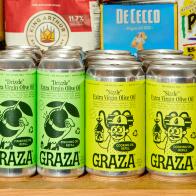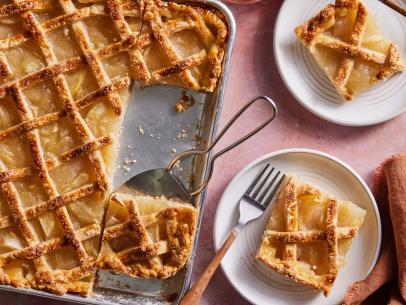
Strawberry Slab Pie
- Level: Intermediate
- Total: 5 hr 30 min
- Active: 50 min
- Yield: 1 slab pie (8 to 10 servings)
-
- Nutritional Analysis
- Per Serving
- Serving Size
- 1 of 8 servings
- Calories
- 296
- Total Fat
- 3 g
- Saturated Fat
- 1 g
- Carbohydrates
- 63 g
- Dietary Fiber
- 3 g
- Sugar
- 34 g
- Protein
- 5 g
- Cholesterol
- 76 mg
- Sodium
- 309 mg
- Level: Intermediate
- Total: 5 hr 30 min
- Active: 50 min
- Yield: 1 slab pie (8 to 10 servings)
-
- Nutritional Analysis
- Per Serving
- Serving Size
- 1 of 8 servings
- Calories
- 296
- Total Fat
- 3 g
- Saturated Fat
- 1 g
- Carbohydrates
- 63 g
- Dietary Fiber
- 3 g
- Sugar
- 34 g
- Protein
- 5 g
- Cholesterol
- 76 mg
- Sodium
- 309 mg
Ingredients
Master Double-Crust Pate Brisee
Directions
- Make the Double-Crust Pate Brisee and divide it in half. Place one half back in the fridge while you work with the other.
- Generously flick flour over the work surface and roll out the dough into a rectangle about 1/4 inch thick and large enough to line the bottom and sides of a rimmed 9 x 13-inch quarter-sheet pan or baking pan. Line the bottom and sides of the pan with the dough, making sure to press the dough into the corners. You may need to patch it up if the dough tears. Dock it with a pastry docker (see Cook's Note) or by poking it all over with a fork. Refrigerate the pie shell for at least 30 minutes to allow the dough to relax.
- Meanwhile, line a baking sheet or large flat platter with parchment paper and set aside. Remove the other half of the dough from the fridge and roll it into a rectangle about 1/4 inch thick and large enough to cover the whole top of the pie. Place the rolled-out dough on the prepared baking sheet or platter and refrigerate until you are ready to use it.
- Preheat the oven to 350 degrees F and place a rack in the center of the oven. Line the pie shell with parchment paper and fill it with pie weights, dried beans, or uncooked rice. Blind bake the pie shell (see Cook's Note) for 20 to 30 minutes, rotating the pan midway through the baking time, until the pie shell is matte and pale golden brown. Remove it from the oven and let cool on a wire rack. When the pie weights have cooled down, remove them carefully from the pie shell and discard the parchment. Set aside the pie shell.
- In a medium bowl, combine the strawberries, superfine sugar, cornstarch, orange zest, and salt and toss to combine well. Let macerate for about 15 minutes. Pour the fruit and any accumulated juices over the pie shell. Remove the rolled-out dough from the fridge and drape it over the pie. Press the dough gently along the rim of the pan to adhere it to the edges of the bottom crust. Trim any excess dough so that there is just a slight overhang (the dough will shrink during baking, so you want there to be a little extra along the edge). Whisk the egg for the egg wash in a small bowl with a fork. Use a pastry brush to lightly brush the top of the dough with the egg wash. Sprinkle the top evenly with the sanding sugar. Slit the dough decoratively in 6 to 8 places to allow steam to escape while baking. Bake for 40 to 50 minutes, rotating the pan midway through the baking time, until the top is dark golden brown through and through--no pale soggy places!
- Remove the pie from the oven and let cool on a wire rack for at least 2 hours, so the fruit has time to set up. Serve warm or at room temperature.
- The pie can be stored well covered, at room temperature for up to 1 day or in the fridge for up to 3 days. If you store it in the fridge, it's best served warmed; reheat the pie in a 300 degrees F oven for 15 to 20 minutes, until the top and bottom crisp up a little bit.
Master Double-Crust Pate Brisee
- In a stand mixer fitted with a paddle attachment, paddle together the flour, sugar, and salt for 10 to 15 seconds. Cut the butter into about 12 pieces and add it to the flour mixture. Paddle slowly until the flour is no longer bright white and the mixture holds together when you clump it, and there are still lumps of butter the size of pecans throughout, 60 to 90 seconds.
- Whisk together the egg yolks and milk in a small bowl and add them all at once to the flour-butter mixture. Paddle very briefly, just until it barely comes together, about 30 seconds. It will look really shaggy and more like a mess than a dough.
- Dump the dough out onto a clean work surface and gather it together into a tight mound. Using the heel of your hand, smear the dough, starting at the top of the mound and sliding your hand down the sides of the mound along the work surface, until most of the butter chunks are smeared into the dough and the whole thing comes together.
- Wrap the dough tightly in plastic wrap and press it down to make a disk about 1 inch thick. Refrigerate for at least 1 hour before using.
- The dough can be stored in the refrigerator for up to 4 days or in the freezer for up to 4 weeks. Wrap in another layer of plastic if storing for more than 1 day.
Cook’s Note
When baking pie and tart shells, you are often instructed to dock (poke holes into) the dough before baking. You can get a fancy docker that looks like a lint roller with spikes, or you can just use a fork. Docking the shell allows air to escape when you bake it. Tart and pie dough have a fair amount of liquid in them from the butter, eggs, and any other liquid you've mixed in. When the dough goes into the oven, the liquids turn to steam with the heat. This steam can cause big bubbles to form in the shell unless you give it a way to escape. Hence you dock pastry shells. If you are filling the tart with a liquid filling after you blind bake it, take care not to dock too aggressively. A few holes here and there will be enough to release the steam but not so much that the liquid filling leaks out. Tart and pie shells often need to be partially baked before you fill them. This is called blind baking. If you don't bake the pie shell first, it can't fully bake once it is filled, and the result is an underbaked, gummy, doughy crust. Line the unbaked shell with parchment paper or a large coffee filter, and then place a generous amount of pie weights, unbaked dried beans, un-cooked rice, or even well-washed rocks on it to fill the shell fully. Press down slightly on the weights to make sure the shell is entirely filled, and place the whole thing in the oven. The pie weights will keep the shell from bubbling and puffing up. Check the shell for doneness by lifting the parchment and peeking at the color of the baked shell. It should be light golden and look matte; if it's shiny, it needs to bake longer. Be careful when peeking that the weights don't slip under the parchment and bake into the pie dough, especially if you are using rice. When the pie shell is done baking, remove it from the oven and let cool until you can remove the parchment and weights.


































